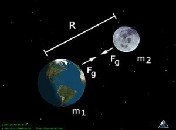Newtonian mechanics
According to classical mechanics, between two or more masses (or other forms of energy–momentum) a gravitational potential energy exists. Conservation of energy requires that this gravitational field energy is always negative.[2]
Particularly, between any two point masses  and
and  (this works for the spherical bodies also), there always exists a gravitational force of
(this works for the spherical bodies also), there always exists a gravitational force of  where r is the distance between their centers. Increasing the distance from
where r is the distance between their centers. Increasing the distance from  to
to  reduces the force, but, since forces in Newton mechanics indicate how much potential energy is lost over space,
reduces the force, but, since forces in Newton mechanics indicate how much potential energy is lost over space,  , this separation requires
, this separation requires  of energy. Performing positive work equal to E units of energy, we can recede objects from r0 to r1 special units apart. By performing positive work equal to
of energy. Performing positive work equal to E units of energy, we can recede objects from r0 to r1 special units apart. By performing positive work equal to  , the second term vanishes and objects are infinitely separated (
, the second term vanishes and objects are infinitely separated ( ). Because gravitational force stops pulling objects together at that distance,
). Because gravitational force stops pulling objects together at that distance,  is known as gravitational binding energy, which is infinite at
is known as gravitational binding energy, which is infinite at  since the gravitational force is infinite there[citation needed].
since the gravitational force is infinite there[citation needed].




